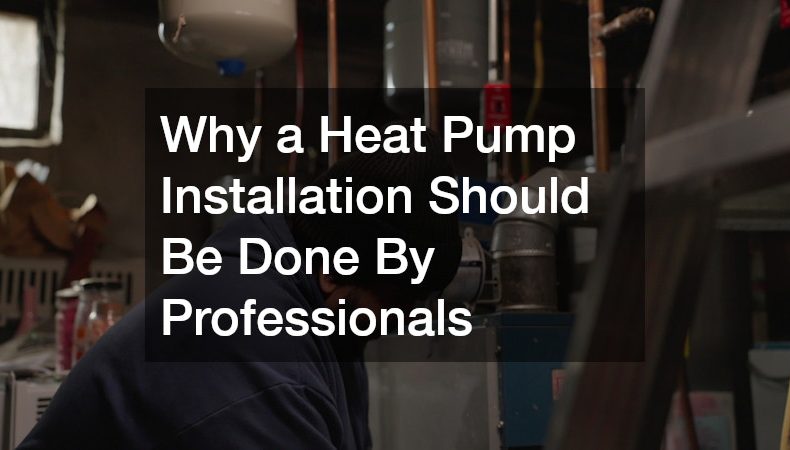
Why a Heat Pump Installation Should Be Done By Professionals
In this article, we explore the reasons why professional installation is essential when it comes to heat pumps. We’ll address common concerns and highlight the benefits of relying on certified specialists for this task. Heat pumps are complex systems that require precise handling and expertise to ensure optimal functionality. By opting for professional installation, homeowners can avoid potential pitfalls and enjoy the full benefits of this technology. Understanding the nuances of installation can make the difference between a heat pump that operates seamlessly and one fraught with issues.
1. What are the Risks of DIY Heat Pump Installation?
1.1 Potential Safety Hazards
Installing a heat pump involves handling electrical components and refrigerants, which pose significant safety hazards. Incorrect handling can lead to electrical shocks or refrigerant leaks, both of which can have serious consequences. Additionally, DIY installations might not comply with local safety codes, which could result in penalties. Professional installers are trained to adhere to these regulations, ensuring safety standards are met. The technical nature of heat pumps also demands a deep understanding of electrical circuits, making it unsuitable for amateurs. Certified professionals are well-versed in these complexities, minimizing the risks associated with installation.
1.2 Impact on System Performance
Improper installation of a heat pump can lead to reduced system efficiency, negating its energy-saving benefits. An incorrectly installed system may work harder to maintain comfort levels, resulting in higher energy consumption and increased utility bills. Moreover, DIY installations can result in uneven heating or cooling, affecting the overall comfort of the home. Professional installers are equipped with the knowledge to ensure that the system operates at its optimal efficiency. Several studies have shown that professional installations can enhance system performance by up to 30%, reinforcing the importance of expert handling. Thus, engaging professionals not only safeguards the equipment but also maximizes its performance.
2. How Can Professional Installation Save You Money?
2.1 Energy Efficiency and Lower Utility Bills
Professionally installed heat pumps are often more energy-efficient, leading to significant savings on utility bills. These systems are calibrated to operate at peak efficiency, reducing overall energy consumption. With rising energy costs, an efficient system helps in containing monthly expenses while providing optimal indoor comfort. Furthermore, professional installers can recommend energy-saving practices and system upgrades, contributing to further cost reductions. The investment in professional installation often translates to long-term financial savings due to decreased energy usage. Over time, these savings can offset the initial installation costs, making it a wise choice financially.
2.2 Avoiding Costly Repairs
One of the hidden costs of DIY installation is the increased likelihood of requiring ongoing repairs. Improper installation may lead to frequent malfunctions, resulting in unexpected expenses for homeowners. Professional installation minimizes the risk of such failures through meticulous attention to detail and thorough system checks. Certified technicians can identify potential issues during installation, addressing them proactively before they evolve into major problems. This approach not only ensures system reliability but also extends the life of the equipment. Ultimately, the upfront cost of professional installation can prevent more significant expenses associated with recurrent repairs.
3. What Qualifications Should a Professional Installer Have?
3.1 Necessary Certifications and Training
A qualified heat pump installer should possess specific certifications that demonstrate their competency and knowledge in handling the system. Common certifications include NATE (North American Technician Excellence) and EPA (Environmental Protection Agency) credentials, which are indicative of a technician’s ability to manage installation tasks appropriately. These certifications ensure that the installer is up to date with the latest technologies and safety protocols. Training is critical, as it ensures that installers can address various installation scenarios effectively. In addition, professional associations often require members to undertake continuous education, ensuring they remain proficient in installing the latest models. Homeowners are advised to verify these qualifications to guarantee an expert installation.
3.2 Experience and Expertise
Experience plays a significant role in ensuring a successful heat pump installation. An experienced installer has encountered a range of installation challenges and developed the expertise to address them efficiently. This wealth of experience translates into quality workmanship, reducing the likelihood of errors that could compromise the system’s functionality. Moreover, seasoned professionals can offer valuable insights and recommendations tailored to the specific needs of a home, improving overall comfort. Choosing an installer with a solid track record provides peace of mind, knowing that the system is in capable hands. A well-executed installation is integral to the system’s longevity and performance.
4. What to Expect During a Professional Heat Pump Installation?
4.1 Initial Assessment and Planning
Before the installation process begins, a professional installer conducts a thorough assessment of the home to determine the most suitable approach. This evaluation considers factors such as the size of the home, insulation quality, and specific heating and cooling requirements. A customized installation plan is then developed to ensure that the system meets the homeowner’s expectations and optimally suits the environment. Additionally, any necessary adjustments to accommodate the system’s installation are identified and addressed during this phase. This planning process assures that the installation is seamless, with minimal disruption to the household. Qualified installers use this stage to align with the manufacturer’s guidelines and recommendations, setting the foundation for a successful installation.
4.2 Installation Process and Testing
The installation of a heat pump involves several steps, including positioning the unit, connecting electrical components, and charging refrigerants. These tasks require precision and technical knowledge to ensure that each component functions correctly. After installation, professional technicians conduct rigorous testing to verify the system’s performance across different modes and conditions. This comprehensive testing phase is crucial in identifying any initial issues and ensuring the system operates seamlessly. Furthermore, installers provide a detailed walkthrough for homeowners, explaining system functionalities and maintenance tips. These procedures are integral to achieving optimal system performance and longevity.

You may also like
Calendar
| M | T | W | T | F | S | S |
|---|---|---|---|---|---|---|
| 1 | 2 | |||||
| 3 | 4 | 5 | 6 | 7 | 8 | 9 |
| 10 | 11 | 12 | 13 | 14 | 15 | 16 |
| 17 | 18 | 19 | 20 | 21 | 22 | 23 |
| 24 | 25 | 26 | 27 | 28 | 29 | 30 |
Leave a Reply